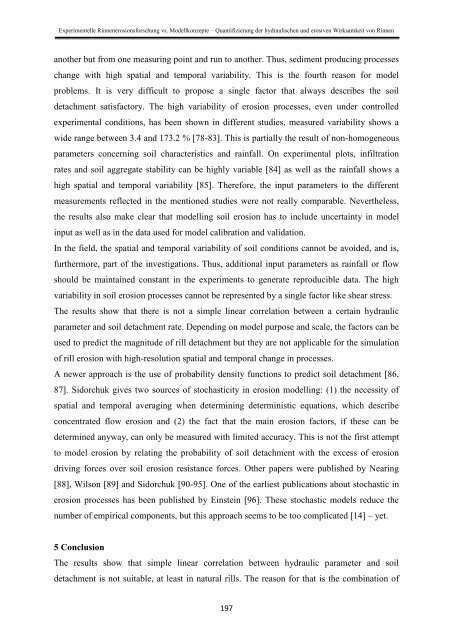Stefan Wirtz Vom Fachbereich VI (Geographie/Geowissenschaften ...
Stefan Wirtz Vom Fachbereich VI (Geographie/Geowissenschaften ...
Stefan Wirtz Vom Fachbereich VI (Geographie/Geowissenschaften ...
Create successful ePaper yourself
Turn your PDF publications into a flip-book with our unique Google optimized e-Paper software.
Experimentelle Rinnenerosionsforschung vs. Modellkonzepte – Quantifizierung der hydraulischen und erosiven Wirksamkeit von Rinnen<br />
another but from one measuring point and run to another. Thus, sediment producing processes<br />
change with high spatial and temporal variability. This is the fourth reason for model<br />
problems. It is very difficult to propose a single factor that always describes the soil<br />
detachment satisfactory. The high variability of erosion processes, even under controlled<br />
experimental conditions, has been shown in different studies, measured variability shows a<br />
wide range between 3.4 and 173.2 % [78-83]. This is partially the result of non-homogeneous<br />
parameters concerning soil characteristics and rainfall. On experimental plots, infiltration<br />
rates and soil aggregate stability can be highly variable [84] as well as the rainfall shows a<br />
high spatial and temporal variability [85]. Therefore, the input parameters to the different<br />
measurements reflected in the mentioned studies were not really comparable. Nevertheless,<br />
the results also make clear that modelling soil erosion has to include uncertainty in model<br />
input as well as in the data used for model calibration and validation.<br />
In the field, the spatial and temporal variability of soil conditions cannot be avoided, and is,<br />
furthermore, part of the investigations. Thus, additional input parameters as rainfall or flow<br />
should be maintained constant in the experiments to generate reproducible data. The high<br />
variability in soil erosion processes cannot be represented by a single factor like shear stress.<br />
The results show that there is not a simple linear correlation between a certain hydraulic<br />
parameter and soil detachment rate. Depending on model purpose and scale, the factors can be<br />
used to predict the magnitude of rill detachment but they are not applicable for the simulation<br />
of rill erosion with high-resolution spatial and temporal change in processes.<br />
A newer approach is the use of probability density functions to predict soil detachment [86,<br />
87]. Sidorchuk gives two sources of stochasticity in erosion modelling: (1) the necessity of<br />
spatial and temporal averaging when determining deterministic equations, which describe<br />
concentrated flow erosion and (2) the fact that the main erosion factors, if these can be<br />
determined anyway, can only be measured with limited accuracy. This is not the first attempt<br />
to model erosion by relating the probability of soil detachment with the excess of erosion<br />
driving forces over soil erosion resistance forces. Other papers were published by Nearing<br />
[88], Wilson [89] and Sidorchuk [90-95]. One of the earliest publications about stochastic in<br />
erosion processes has been published by Einstein [96]. These stochastic models reduce the<br />
number of empirical components, but this approach seems to be too complicated [14] – yet.<br />
5 Conclusion<br />
The results show that simple linear correlation between hydraulic parameter and soil<br />
detachment is not suitable, at least in natural rills. The reason for that is the combination of<br />
197
















